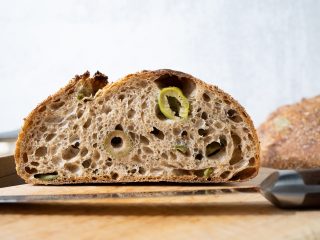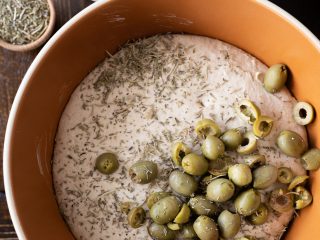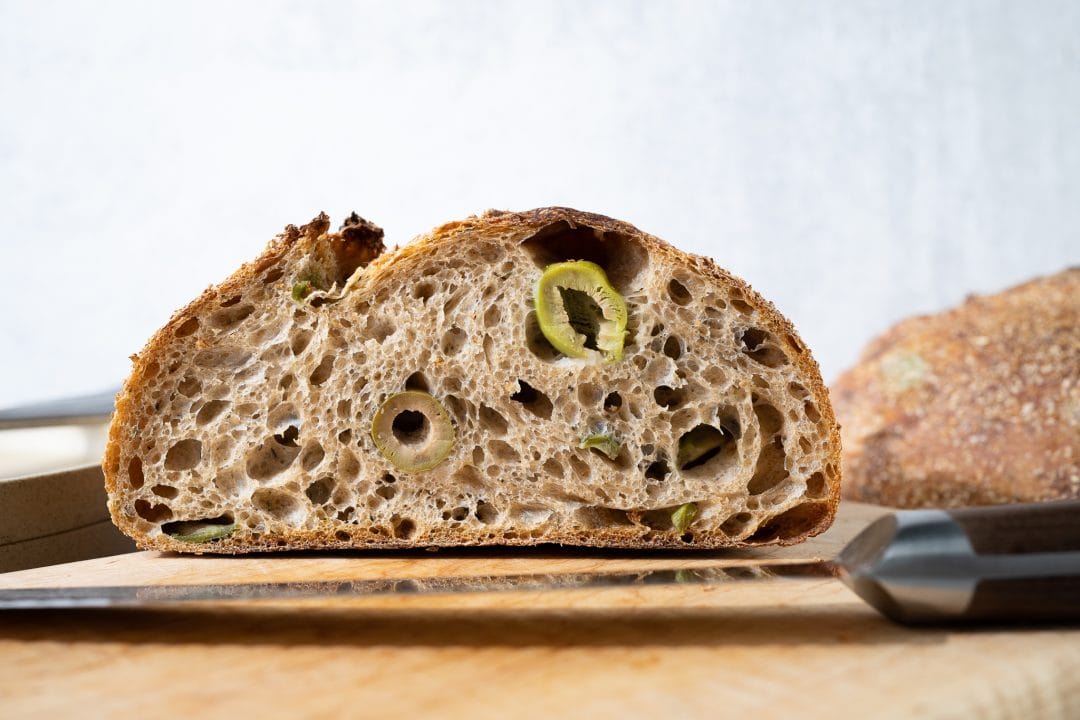This is a simple and hearty bread, but one that has surprising depth thanks to the hefty addition of large green olives and a melange of spice from my favorite herbes de Provence blend. Of course, snagging an olive as you eat is a delight all of its own (I believe there's a place for an olive on every dinner table), but because the tangy, buttery olive flavor pervades the entire loaf, you taste their impact in each bite. Perhaps my favorite part of this green olive and herb sourdough bread, though, is the incredible crust.
When combined with piquant herbs, the small amount of olive juice in the dough transforms the crust into a brittle makeshift cracker deep with concentrated olive and herb flavor. There's always a place for a thick, rustic crust in my baking, but this bread brings joy through a movement in the other direction. Finishing off the loaf with a thick layer of raw wheat germ after shaping echoes the tuft of wild herbs added to the dough, a sort of bread alliteration that leads to a lovely loaf, indeed.

Flour and ingredient selection
Flour
Any high-quality whole wheat flour will work well for the whole-grain portion of this loaf. I used Carolina Ground whole wheat for the entire 30%, which brought significant flavor all on its own.
Green olives
Be sure to rinse your olives under running water and let them dry before mixing them into your dough. While salty brine is welcome in many instances, adding too much to the dough could mean an overly salty loaf of bread. I like to leave the green olives whole in this recipe to show off their striking color and form when this bread is sliced. If you want more olive coverage throughout the loaf, feel free to chop the olives as fine as you'd like. I chopped about a quarter of the olives and left the rest whole.
I chose to use pitted Castelvetrano olives for this loaf, but Frescatrano or other green olive variety would work well with this dough recipe. Also, check out my Tartine olive sourdough bread if you're looking at using your Kalamata or other black olives!

Herbes de Provence
I tested this bread with garden rosemary, thyme, oregano, and a mix of each, but in the end, my choice went with the classic herbes de Provence combination. And if you ask me, this blend nails it when it comes to pairing with olives.
I like the Frontier Herbes de Provence blend, which has savory, thyme, rosemary, basil, tarragon, and lavender. I like to use lavender often, but only in moderation—it's an uncommon but absolutely delightful herb when used conservatively.
Wheat bran topper
To further amplify the crust with this bread—and something I've been doing with a lot of my other loaves lately—I coated the exterior with raw wheat bran. Oftentimes I have this lying around in my fridge after I mill fresh flour and then sift out the larger pieces, so it's a convenient way to use this super-healthy part of the wheat kernel and bring an additional measure of crunch to the crust. If you don't mill flour often, you can find small bags of wheat bran online that are great to have in the refrigerator for topping just about any bread (and to mix into sourdough muffins!).
Baking schedule
This green olive and herb sourdough bread is made over the course of two days. Cold proofing this dough brings additional flavor, but you can always do a same-day bake as well. Instead of placing the shaped dough into the refrigerator to proof overnight, leave it out, covered, to proof for 1-3 hours (depending on kitchen temperatures) until ready to bake.
Green olive and herb sourdough bread formula
Vitals
| Total Dough Weight | 1,800 grams |
| Hydration | 75% |
| Pre-fermented Flour | 6.40% |
| Levain in final dough | 17.09% |
| Yield | 2 x 900g loaves |
This recipe makes two loaves. If you'd like to make a single loaf of green olive and herb sourdough bread, divide all the ingredients in half. See my guide to using baker's percentages for further help with scaling.
Total formula
Desired dough temperature: 78°F (25°C). See my post on the importance of dough temperature for more information on dough temperatures.

Green olive and herb sourdough bread method
1. Prepare the levain – 9:00 a.m.
This is a relatively fast levain, ripening in five hours. Mix the following ingredients in a container and leave them covered to ripen at a warm temperature, about 76-78°F (24-25°C) for 5 hours.
| Weight | Ingredient | Baker’s Percentage |
|---|---|---|
| 28g | Medium-protein bread flour or all-purpose flour | 50.00% |
| 28g | Whole wheat flour | 50.00% |
| 57g | Water | 100.00% |
| 28g | Ripe sourdough starter | 50.00% |
2. Autolyse – 1:00 p.m.
This recipe uses the autolyse technique to increase the extensibility of the dough and make mixing by hand easier. Add the following to a mixing bowl and mix until incorporated. Let the mixture rest, covered, for 1-hour.
| Weight | Ingredient |
|---|---|
| 590g | Medium-protein bread flour or all-purpose flour |
| 237g | Whole wheat flour |
| 562g | Water 1 (this is the remaining water 1 after taking some for levain and soaker) |
3. Mix – 2:00 p.m.
Gather the following ingredients for mixing. The remaining water (water 2) should only be added through mixing if your dough feels like it can handle the addition. Next, use a splash to work in the levain and salt, adding the rest if the dough feels cohesive.
| Weight | Ingredient |
|---|---|
| 44g | Water 2 |
| 16g | Fine sea salt |
| 141g | Ripe levain (from step 1) |
Add the levain to the top of your dough already in the mixing bowl, and use a splash of the reserved water to moisten. Mix the levain thoroughly and slap and fold (or do folds in the bowl) for 5 minutes until the dough begins to smooth out and become elastic.
Let the dough rest in the mixing bowl, covered, for 10 minutes.
Sprinkle the salt over the dough, then dissolve with the remaining reserved mixing water. Mix thoroughly. If the dough still feels very slack, continue to strengthen the dough in the bowl by stretching and folding (or do slap/fold on the counter) for a few minutes until it begins to tighten and come together.
Transfer the dough to a container for bulk fermentation and cover.
4. Bulk fermentation – 2:15 p.m. to 6:00 p.m. (3 hours and 45 minutes)
At a warm room temperature, around 74-76°F (23-24°C), bulk fermentation should take about 3 hours and 45 minutes to 4-hours. If your kitchen is cooler, place your bulk container in a small home dough proofer, or extend the bulk fermentation time to give the dough more time to ferment. This dough needs around three sets of stretch and folds during this time.



Before you give your dough its first set of stretches and folds, spread about 1/4 of the olives and herbes over the top of the dough. Then, grab one side of the dough and stretch it up and over it to the other side. Next, spread on another 1/4 of the inclusions to the new top. Rotate the bowl 180° and perform another stretch and fold. Spread on another 1/4 of the inclusions, rotate the bowl 90° and do another stretch and fold. Finally, spread on the last of the olives and herbs, turn the bowl 180° and do one last stretch and fold.
And the end of each set, try to have the dough neatly folded up in the bowl with all inclusions tucked inside, save for a scattered olive or two peeking out.

The remaining two sets of stretch and folds should be more gentle. After the third set, let the dough rest, covered, for the remainder of bulk fermentation.
5. Divide and preshape – 6:00 p.m.
Fill a bowl with some water and place it on your work surface. Scrape out your dough from the bulk container onto your dry counter. Divide the mass in half using a bench knife. Using a wet hand and the knife in the other, gently preshape each half into a taut round.
Let the dough rest, uncovered, for 30 minutes.
6. Shape – 6:40 p.m.
I like to roll this dough in raw wheat germ for a crunchy—and nutritious—topper. Using a quarter baking sheet or clean kitchen towel, spread out a thin layer of wheat germ. After you shape your dough, flip it onto the thin layer and rotate it around to coat. Then, place the dough in a proofing basket, seam-side-up.
For me, this dough was a little slack during preshaping, so I shaped the dough a little extra tight to ensure it keeps its form all the way through proofing. I went with a batard shape and tucked the dough in a few extra times—see my guide to shaping a batard.

After each dough piece is shaped and optionally topped with wheat germ, place it seam side up in a 10-inch long proofing basket lined with canvas or a clean kitchen towel.
7. Proof – 7:00 p.m. to 9:00 a.m. (overnight)
Cover the baskets with a large, reusable plastic bag and seal it shut. Then, place the baskets into your refrigerator to proof overnight.
8. Bake – 9:00 a.m. (next day)
Preheat your oven with a baking stone or Baking Steel inside to 450°F (230°C).
I baked these loaves in my Challenger bread pan, but you could also follow my guide to steaming an oven for baking bread.
Score each piece of dough. Check out my video of how I like to score a bâtard, here:
After you score the dough, slide it into the oven and bake for 20 minutes with steam. Then, remove the steaming pans from inside the oven (or remove the lid to your baking pan) and bake for an additional 30 minutes, or until the crust is deeply colored and the interior temperature registers around 204°F (95°C).
Once fully baked, cool your loaves on a cooling rack for 1-2 hours. See my post on the best way to store bread to keep it fresh for a week or longer.

Despite the rogue olive pushing to the surface, you might not know this green olive and herb sourdough bread has anything different going on—that is until you slice into it and discover large green olives at every turn. This loaf is a strong candidate for any dinner table, but it's also nice when sliced, cubed, and then placed out on a charcuterie board or appetizer spread. The flavor of the bread is striking enough, but it goes extremely well with any aged cheese, aged meat, and, dare I say, more olives.
Buon appetito!

Green olive and herb sourdough bread
- Author: Maurizio Leo
- Prep Time: 24 hours
- Cook Time: 1 hour
- Total Time: 25 hours
- Yield: 2 loaves
- Category: Bread, Sourdough
- Cuisine: American
Description
A hearty loaf of sourdough bread with salty, buttery green olives and herbes de Provence.
Ingredients
Levain
- 28g medium-protein bread flour or all-purpose flour
- 28g whole wheat flour
- 57g water
- 28g ripe sourdough starter
Main Dough
- 590g medium-protein bread flour or all-purpose flour
- 237g whole wheat flour
- 203g Castelvetrano olives, pitted
- 7g herbes de Provence
- 606g water (water 1 + water 2)
- 16g salt
- 141g levain
Optional Topper
- Use raw wheat bran as an optional topper to coat the dough after shaping
Instructions
- Levain (9:00 a.m.)
In a small bowl, mix and knead the Levain ingredients. Transfer to a small container, cover, and keep it at a warm temperature for 5 hours. - Autolyse (1:00 p.m)
In a medium mixing bowl, add the 590g medium-protein bread flour, 237g whole wheat flour, and 562g water 1 and mix until no dry bits remain. Cover the bowl and let rest for 1-hour. - Mix (2:00 p.m.)
Add the levain to the top of your dough already in the mixing bowl, and use a splash of the reserved water to moisten. Mix the levain thoroughly and slap and fold (or do folds in the bowl) for 5 minutes until the dough begins to smooth out and become elastic. Let the dough rest in the mixing bowl, covered, for 10 minutes. Sprinkle the salt over the dough, then dissolve with the remaining reserved mixing water. Mix thoroughly. If the dough still feels very slack, continue to strengthen the dough in the bowl by stretching and folding (or do slap/fold on the counter) for a few minutes until it begins to tighten and come together. Transfer the dough to a container for bulk fermentation and cover. Rinse the olives and optionally chop; set aside. - Bulk Fermentation (2:15 p.m. to 6:00 p.m.)
This dough will need 3 sets of stretches and folds during bulk fermentation where the first set starts after 30 minutes into bulk fermentation and the subsequent sets are at 30-minute intervals. During the first set of stretches and folds, add the olives and herbs as you perform each stretch and fold. After the third set of stretches and folds, let the dough rest, covered, for the remainder of bulk fermentation. - Divide and Preshape (6:00 p.m.)
Lightly flour your work surface and scrape out your dough. Using your bench knife, divide the dough in half. Lightly shape each half into a round shape. Let the dough rest for 30 minutes, uncovered. - Shape (6:40 p.m.)
Shape the dough into a round (boule) or oval (batard) and roll in the whole wheat bran to the top, if desired. Then, place the dough in proofing baskets. - Proof (7:00 p.m. to 9:00 a.m. the next day)
Cover proofing baskets with reusable plastic and seal shut. Then, place both baskets into the refrigerator and proof overnight. - Bake (The next day, bake at 9:00 a.m.)
Preheat your oven with a baking surface or combo cooker/Dutch oven inside to 450°F (230°C).When the oven is preheated, remove your dough from the fridge, score it, and transfer it to the preheated baking surface or combo cooker. Bake for 20 minutes with steam. After this time, vent the steam in the oven or remove the lid (you can keep it in the oven or remove it) and continue to bake for 30 minutes longer. When done, the internal temperature should be around 204°F (95°C).
Let the loaves cool for 2 hours on a wire rack before slicing.
Notes
- Instead of Castelvetrano olives, use Frescatrano or any other pitted green olive
If you use this recipe, tag @maurizio on Instagram so I can take a look!
I don't have Castelvetrano olives; can I use another type of olive for this sourdough bread?

Yes! I like to stick to green olives for this loaf, and any green olive will work well mixed into the dough.
This green olive and herb sourdough bread was very slack, and the dough was hard to handle. What happened?
Try reducing the hydration of the dough a little next time. For example, instead of adding all of the reserved water, only add it in during mixing if the dough can handle the addition.
What's next?
For another herb-forward loaf, check out my apricot and thyme sourdough bread that's 50% whole wheat!



